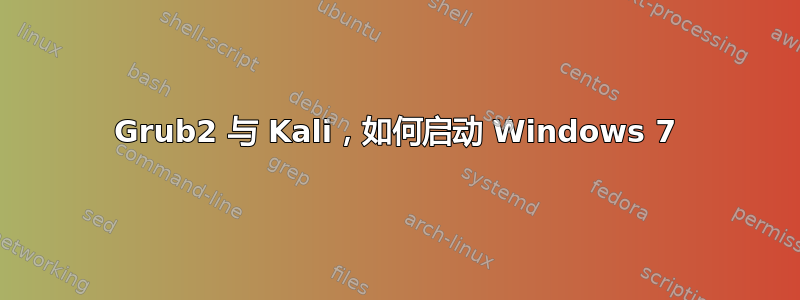
首先我要说一下,我是 Linux 新手。我的主 SSD 上安装了 Windows 7,我想试试 Kali,所以我把它安装在了第二个 SSD 上。当出现安装 grub2 的选项时,由于之前使用过 Ubuntu,所以我把它安装在了主 SSD 上。我现在无法启动 Windows。我试了一下,结果显示sudo update-grub2:
Generating grub.cfg ...
Found background image: /usr/share/images/desktop-base/desktop-grub.png
Found linux image: /boot/vmlinuz-3.18.0-kali3-amd64
Found initrd image: /boot/initrd.img-3.18.0-kali3-amd64
No volume groups found
我运行了 bootinfoscript,得到了以下结果:
=> Grub2 (v1.99) is installed in the MBR of /dev/sda and looks at sector 1 of the same
hard drive for core.img. core.img is at this location and looks for (,msdos1)/boot/grub
on this drive.
=> Windows is installed in the MBR of /dev/sdb.
sda1: __________________________________________________________________________
File system: ext4
Boot sector type: -
Boot sector info:
Mounting failed: mount: /dev/sda1 already mounted or sda1 busy
sda2: __________________________________________________________________________
File system: Extended Partition
Boot sector type: -
Boot sector info:
sda5: __________________________________________________________________________
File system: swap
Boot sector type: -
Boot sector info:
sdb1: __________________________________________________________________________
File system: ntfs
Boot sector type: Windows Vista/7: NTFS
Boot sector info: No errors found in the Boot Parameter Block.
Operating System: Windows 7
Boot files: /Windows/System32/winload.exe
驱动器/分区信息:
Drive: sda _____________________________________________________________________
Disk /dev/sda: 128.0 GB, 128035676160 bytes
255 heads, 63 sectors/track, 15566 cylinders, total 250069680 sectors
Units = sectors of 1 * 512 = 512 bytes
Sector size (logical/physical): 512 bytes / 512 bytes
Partition Boot Start Sector End Sector # of Sectors Id System
/dev/sda1 * 2,048 239,855,615 239,853,568 83 Linux
/dev/sda2 239,857,662 250,068,991 10,211,330 5 Extended
/dev/sda5 239,857,664 250,068,991 10,211,328 82 Linux swap / Solaris
Drive: sdb _____________________________________________________________________
Disk /dev/sdb: 512.1 GB, 512110190592 bytes
255 heads, 63 sectors/track, 62260 cylinders, total 1000215216 sectors
Units = sectors of 1 * 512 = 512 bytes
Sector size (logical/physical): 512 bytes / 512 bytes
Partition Boot Start Sector End Sector # of Sectors Id System
/dev/sdb1 2,048 1,000,212,479 1,000,210,432 7 NTFS / exFAT / HPFS
“blkid”输出:
Device UUID TYPE LABEL
/dev/sda1 6cb27243-ec3c-45c8-a66d-7316fb1db39c ext4
/dev/sda5 e9e1f9dc-7998-4ec7-b8a2-36c7bf60906a swap
/dev/sdb1 2A0CBB1D0CBAE34D ntfs
挂载点:
Device Mount_Point Type Options
/dev/disk/by-uuid/6cb27243-ec3c-45c8-a66d-7316fb1db39c / ext4 (rw,relatime,errors=remount-ro,data=ordered)
似乎没有相应硬盘的设备:
sdc
StdErr 消息:
xz: (stdin): Compressed data is corrupt
No volume groups found
我不知道如何重新启动我的 Windows 7。提前感谢你的帮助。如果需要任何其他信息,请告诉我。
编辑1:
# If you change this file, run 'update-grub' afterwards to update
# /boot/grub/grub.cfg.
# For full documentation of the options in this file, see:
# info -f grub -n 'Simple configuration'
GRUB_DEFAULT=0
GRUB_TIMEOUT=5
GRUB_DISTRIBUTOR=`lsb_release -i -s 2> /dev/null || echo Debian`
GRUB_CMDLINE_LINUX_DEFAULT="quiet"
GRUB_CMDLINE_LINUX=""
# Uncomment to enable BadRAM filtering, modify to suit your needs
# This works with Linux (no patch required) and with any kernel that obtains
# the memory map information from GRUB (GNU Mach, kernel of FreeBSD ...)
#GRUB_BADRAM="0x01234567,0xfefefefe,0x89abcdef,0xefefefef"
# Uncomment to disable graphical terminal (grub-pc only)
#GRUB_TERMINAL=console
# The resolution used on graphical terminal
# note that you can use only modes which your graphic card supports via VBE
# you can see them in real GRUB with the command `vbeinfo'
#GRUB_GFXMODE=640x480
# Uncomment if you don't want GRUB to pass "root=UUID=xxx" parameter to Linux
#GRUB_DISABLE_LINUX_UUID=true
# Uncomment to disable generation of recovery mode menu entries
#GRUB_DISABLE_RECOVERY="true"
# Uncomment to get a beep at grub start
#GRUB_INIT_TUNE="480 440 1"
和
#
# DO NOT EDIT THIS FILE
#
# It is automatically generated by grub-mkconfig using templates
# from /etc/grub.d and settings from /etc/default/grub
#
### BEGIN /etc/grub.d/00_header ###
if [ -s $prefix/grubenv ]; then
load_env
fi
set default="0"
if [ "${prev_saved_entry}" ]; then
set saved_entry="${prev_saved_entry}"
save_env saved_entry
set prev_saved_entry=
save_env prev_saved_entry
set boot_once=true
fi
function savedefault {
if [ -z "${boot_once}" ]; then
saved_entry="${chosen}"
save_env saved_entry
fi
}
function load_video {
insmod vbe
insmod vga
insmod video_bochs
insmod video_cirrus
}
insmod part_msdos
insmod ext2
set root='(hd0,msdos1)'
search --no-floppy --fs-uuid --set=root 6cb27243-ec3c-45c8-a66d-7316fb1db39c
if loadfont /usr/share/grub/unicode.pf2 ; then
set gfxmode=640x480
load_video
insmod gfxterm
insmod part_msdos
insmod ext2
set root='(hd0,msdos1)'
search --no-floppy --fs-uuid --set=root 6cb27243-ec3c-45c8-a66d-7316fb1db39c
set locale_dir=($root)/boot/grub/locale
set lang=en_US
insmod gettext
fi
terminal_output gfxterm
set timeout=5
### END /etc/grub.d/00_header ###
### BEGIN /etc/grub.d/05_debian_theme ###
insmod part_msdos
insmod ext2
set root='(hd0,msdos1)'
search --no-floppy --fs-uuid --set=root 6cb27243-ec3c-45c8-a66d-7316fb1db39c
insmod png
if background_image /usr/share/images/desktop-base/kali-grub.png; then
set color_normal=white/black
set color_highlight=black/white
else
set menu_color_normal=cyan/blue
set menu_color_highlight=white/blue
fi
### END /etc/grub.d/05_debian_theme ###
### BEGIN /etc/grub.d/10_linux ###
menuentry 'Kali GNU/Linux, with Linux 3.18.0-kali3-amd64' --class kali --class gnu-linux --class gnu --class os {
load_video
insmod gzio
insmod part_msdos
insmod ext2
set root='(hd0,msdos1)'
search --no-floppy --fs-uuid --set=root 6cb27243-ec3c-45c8-a66d-7316fb1db39c
echo 'Loading Linux 3.18.0-kali3-amd64 ...'
linux /boot/vmlinuz-3.18.0-kali3-amd64 root=UUID=6cb27243-ec3c-45c8-a66d-7316fb1db39c ro quiet
echo 'Loading initial ramdisk ...'
initrd /boot/initrd.img-3.18.0-kali3-amd64
}
menuentry 'Kali GNU/Linux, with Linux 3.18.0-kali3-amd64 (recovery mode)' --class kali --class gnu-linux --class gnu --class os {
load_video
insmod gzio
insmod part_msdos
insmod ext2
set root='(hd0,msdos1)'
search --no-floppy --fs-uuid --set=root 6cb27243-ec3c-45c8-a66d-7316fb1db39c
echo 'Loading Linux 3.18.0-kali3-amd64 ...'
linux /boot/vmlinuz-3.18.0-kali3-amd64 root=UUID=6cb27243-ec3c-45c8-a66d-7316fb1db39c ro single
echo 'Loading initial ramdisk ...'
initrd /boot/initrd.img-3.18.0-kali3-amd64
}
### END /etc/grub.d/10_linux ###
### BEGIN /etc/grub.d/20_linux_xen ###
### END /etc/grub.d/20_linux_xen ###
### BEGIN /etc/grub.d/30_os-prober ###
### END /etc/grub.d/30_os-prober ###
### BEGIN /etc/grub.d/40_custom ###
# This file provides an easy way to add custom menu entries. Simply type the
# menu entries you want to add after this comment. Be careful not to change
# the 'exec tail' line above.
### END /etc/grub.d/40_custom ###
### BEGIN /etc/grub.d/41_custom ###
if [ -f $prefix/custom.cfg ]; then
source $prefix/custom.cfg;
fi
### END /etc/grub.d/41_custom ###
需要帮助请叫我。


